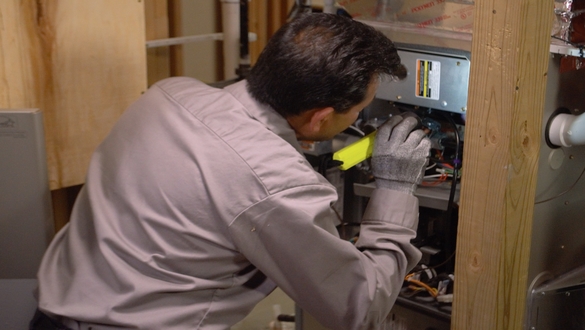5 ways to improve air quality in your Minnesota home

Keeping your home healthy requires attention to its air quality: namely, reducing invisible air pollutants that can be damaging to health.
CenterPoint Energy’s Home Service Plus® (HSP) offers Minnesota residents a variety of products that can be used alone or in conjunction with these tips for improving the air quality in your home…
Understanding indoor air quality
Indoor air quality matters because, just like outdoor air, indoor air can be polluted and unhealthy for your home’s occupants. In fact, indoor air
may contain higher levels of pollutants than outdoor air.
Indoor air quality is affected by many variables. For example, pollutants can enter from outside or attached garages where fuels, paints and cleaning products that may contain known carcinogens are stored. Cleaning products used inside the home, from bleach in the toilet cleaner to the volatile organic compounds (VOCs) in air fresheners, can pose health risks to those inside, particularly children.
Even products we bring into the home that we may not associate with air quality, including personal care products, chemically treated upholstery, household cleaners and pesticides may have a detrimental effect on indoor air quality.
Smoking, along with cooking, heating, remodeling projects and other activities can introduce harmful pollutants into the air inside your home. When fuels are incompletely burned in space heaters, gas stoves, wood stoves and fireplaces, carbon monoxide, nitrogen dioxide and
particles that irritate the lungs may be released.
Some air quality factors are out of our control, such as biological pollutants like pollen, ragweed, and mold that can cause allergies, breathing problems or asthma attacks. And where we live has an effect on these, as well.
A few facts about air quality in Minnesota:
Improving indoor air quality
1. Maintain proper ventilation
If
outdoor air quality is acceptable, consider introducing fresh air into your home. To a certain degree, this happens passively in every home as air seeps through cracks and joints throughout the home, in a process called infiltration. But to increase air exchange, you need to use either
natural ventilation or mechanical means.
Natural ventilation is as easy as opening windows and doors. You may want to switch off your air conditioner before going this route, as running it with open doors and windows wastes energy and could overstress your unit. If you have window screens and/or a storm door with a screen, you can enjoy the outdoor air without the risk of letting in pests.
The other ventilation option is to use heat recovery ventilators (HRVs), kitchen range hoods, bathroom exhaust fans and other devices–ideally in combination with open doors and windows– to cycle poor air out and fresh air in. To discourage mold growth, bathroom fans should be used every time someone in your home takes a shower, and vent hoods should be used whenever cooking with gas to remove the heat, odors, CO2 and moisture generated from the air.
Discover HRVs from HSP
Heat recovery ventilators (HRVs) introduce fresh outdoor air into your home while maintaining energy efficiency.
Improve your indoor air quality today with an HRV.
2. Schedule regular maintenance

Another way to improve your indoor air quality while extending the life of your heating, ventilation and air conditioning (HVAC) equipment is to have a professional technician inspect your HVAC equipment once to twice per year, preferably before the advent of the heating and cooling seasons.
An HVAC checkup may include refilling fluid levels, checking electrical connections, cleaning drain lines and inspecting exhaust outlets.
Although your annual or semi-annual checkup will include it, you can and should be continually monitoring the HVAC filter yourself. Your HVAC system’s air filter pulls pollutants such as dirt, dust, mold, pollen, animal fur, and even bacteria out of the air that is being circulated around your home. As it does this, it begins to clog and needs to be cleaned (if it’s washable) or replaced periodically. Ideally, it should be replaced at least every four months, with the changing of the seasons.
3. Use air purifiers
Air conditioners don’t purify air completely; for that, you may need a dedicated air purifier. Mechanical purifiers such as HEPA purifiers utilize a fiberglass filter that traps particles smaller than 0.1 μm as they pass through.
Some HEPA models also feature UV purification, which uses a process called ultraviolet germicidal irradiation to eradicate airborne microorganisms instead of nonliving particulates. Standalone UV purifiers are also an option, as are adsorbent purifiers that utilize activated charcoal.
For an HVAC-compatible solution, HSP has an offering of air cleaners that connect directly to your furnace and remove larger particles such as pet dander and chemical fumes.
4. Control the humidity level
Humid air encourages the growth of mold and mildew, while trapping and concentrating airborne pollutants. But humidity that is too low can worsen respiratory problems such as asthma. To get the right level, you can incorporate dehumidifiers in the summer and humidifiers in the winter.
Humidifiers like the Aprilaire™ model carried by HSP can provide relief from dry skin, sore throats and other wintertime maladies.
5. Consider an air duct cleaning
Cleaning air ducts–the steel or aluminum conduits that carry warm or cool air around the home–can be a helpful part of HVAC maintenance, and like filter replacement it can help extend the life of your system.
HSP’s air duct cleaning service includes cleaning of dirty cooling coils, furnace blower assembly, registers and more that can improve heating and cooling efficiency. We use high pressure cleaning with compressed air to dislodge dust, dirt, pollen, lint and other irritants from the ductwork.
HSP is a breath of fresh air
Keep your home’s air as fresh and healthy as possible. Home Service Plus has the expert advice and high-quality air improvement products to help.
